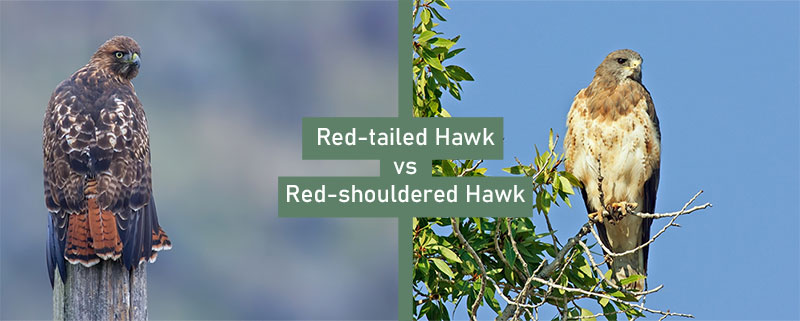
Red-tailed Hawk vs Red-shouldered Hawk – they look similar, and they are named after their physical features, but how similar are they really?
There are many species of raptors – 34 in North America alone. Many have a similar body plan and matching colors – most commonly, various brown, white, and rusty red patterns.
Therefore, while it is improbable to mistake a raptor for any other bird, individual species of raptors are regularly misidentified. That’s why it is useful to know the identification details that set each one apart.
The Red-tailed Hawk and the Red-shouldered Hawk belong to the same genus of falcons or buzzards (Buteo). However, this is where most similarities end. Let’s get into the exact differences between the two species.
On this page
Body & Shape
Red-tailed Hawk is the bigger species of the two. In flight, it displays broad, rounded wings. Also, it shows a tremendous variation in plumage patterns, and there are many regional variants on both the light and dark ends of the spectrum.
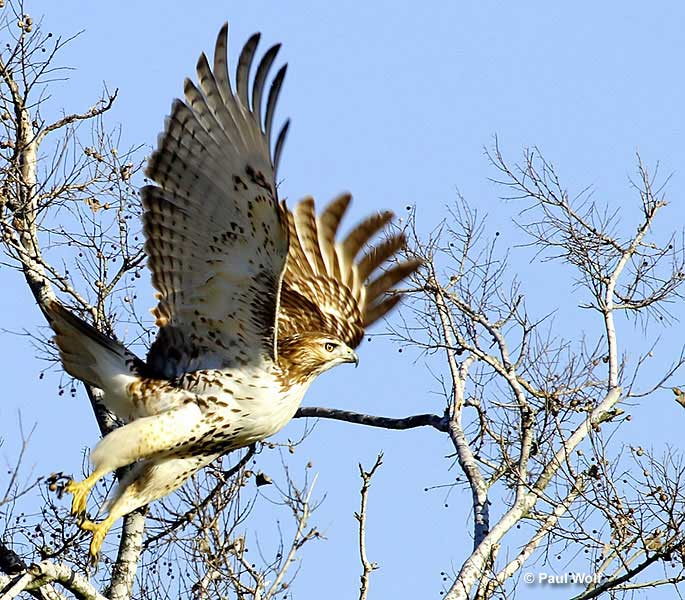
Red-tailed Hawk
However, most (especially the Eastern populations) have a brilliant brick-red colored tail, both when viewed from above and below. The undersides are pale, with dark markings on the stomach.
However, if you’re looking at juvenile birds, things get confusing. Immature Red-tailed Hawks lack the namesake tails – instead, there are brown and white streaks or bars, similar to the young Red-shouldered Hawks. The difference is that the dark bands of the latter are darker and broader.
Also, some regional variations, such as the very dark “Harlan’s Hawk” that breeds in Alaska and northwestern Canada, lack the typical red tail.
Smaller than Red-tailed Hawk, The Red-shouldered Hawk is named for its distinct wing color – you’ve guessed it, the distinct reddish-orange. The undersides of the wings are rich orange with black and white banded flight feathers; the orange color is also frequently present on the underparts.
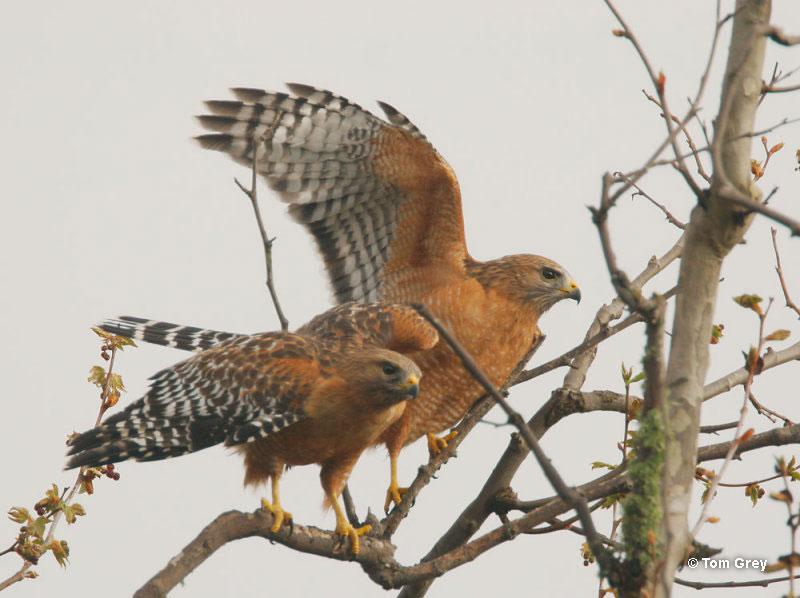
Red-shouldered Hawks
The upper sides of the Red-shouldered’s wings are contrasting and attractively checkered, varying from orange-brown-white to nearly black (dark brown) and white. When we compare them in flight, the wings seem narrower and more forward-facing than with the Red-tailed Hawk or the Broad-winged Hawk.
Western (and especially Californian) populations have richer colors (deeper orange hues), while Eastern is paler, regionally with less or no reddish color on the back.
The Red-shouldered Hawk has a black and white tail – black with white bands, to be precise. It is relatively long but still shorter than in the Red-tailed Hawk.
Red-tailed Hawk vs Red-shouldered Hawk Size
The Red-tailed Hawkcan reach 48 to 65 centimeters (~1.5-2 ft.) in length, with a wingspan of up to 135 cm (~4.4 ft.). The weight ranges from around 800 grams to 1.2kg, meaning they’re incredibly lightweight when compared to their size.
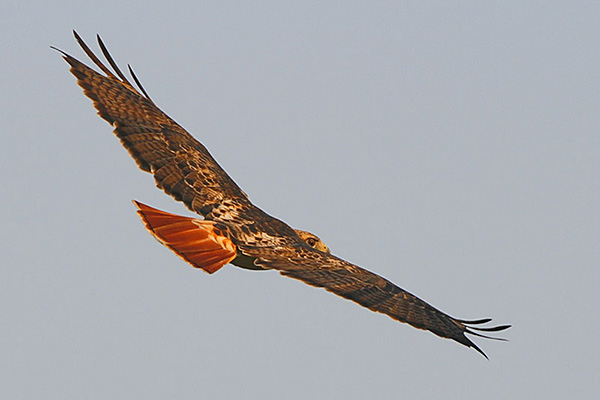
Red-tailed Hawks are bigger in size.
The Red-tailed Hawk is slightly bigger of the two species and one of the larger hawks in North America.
The average Red-shouldered Hawks measure from 43 to 61 cm in length and weigh 550-700 g. The usual wingspan measures from 91 to 101 cm.
In both species, females are larger than males, which is a sexual dimorphism trait we find in many species of raptors.
Speed
Like many raptors, the Red-Tailed Hawk can achieve incredible speeds in flight. Their flying speed is 20-40 miles per hour and up to 120 mph when diving.
Somewhat slower, the Red-shouldered Hawk’s speed in flight can reach 18-34 mph. This is to be expected based on its smaller wing span.
Age
The lifespans of these two species seem to be pretty similar, which is to be expected when you consider their comparable ecologies and life histories.
In both species, most wild birds do not live to be more than two years old. However, after passing this critical age, their longevity can be quite impressive.
The oldest known wild Red-tailed Hawk was at least 30 years and 8 months old on its last record. Researchers first caught and banded this male in 1981, and it was re-captured in 2011.
The oldest wild Red-shouldered Hawk was a female, at least 25 years and 10 months old when last seen. Ornithologists first caught and banded her in California in 1974; to their delight, she was re-captured and re-released in 2000.
Red-tailed Hawk vs Red-shouldered Hawk Behavior
You’ll often find the Red-tailed Hawk near roadsides. In fact, it is the most common roadside raptor in most places of the North American continent.
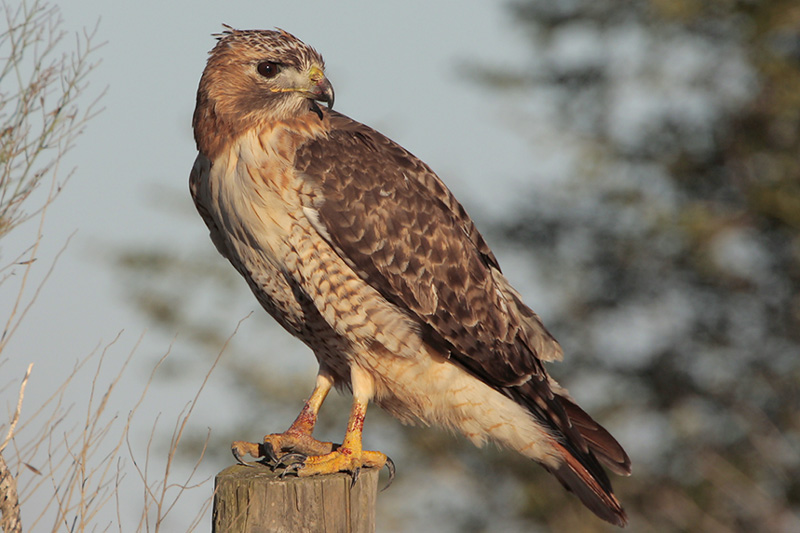
Red-tailed Hawk perched on a pole.
This raptor will commonly use light posts, telephone poles, and tree edges as perches to watch for prey. Impressively, people have spotted Red-tailed Hawk pairs hunting together, with one guarding one side of a tree while the other guards the opposite side to capture tree squirrels.
The Red-shouldered Hawk’s preferred habitats are forested areas. There, they hunt from natural perches but also perch on wires more often than Red-tailed Hawk.
Both species are migratory and move south of their breeding grounds for the winter.
Sounds and Calls
Do you know the typical shrieking raptor sound effect repeating in every Holywood? You may be surprised to hear that it’s actually not the Bald eagle – or any eagle whatsoever. In fact, that most typical raptor call comes from the Red-tailed Hawk!
This classic Red-tailed “kee-eeee-arrr” call is also picturesquely called a “horse scream.” The quality of the call varies within regional populations as well as among individual hawks.
A bit differently, the Red-shouldered Hawks let out a high-pitched, rising, and whistled “kee-rah” sound. The birds often repeat the calls several times in a row, which is also a distinction from the Red-tailed Hawk.
Courtship Behavior
The Red-tailed Hawks engage in a charming courtship display. It begins with flying in wide circles at a great height. The male Red-tailed dives steeply and then quickly ascends also at a nearly-vertical angle.
After several repetitions, he approaches his female partner from above and extends his legs, briefly touching her. Occasionally, the pair may hold onto each other, seize each other’s talons, and spiral toward the ground before separating.
The Red-shouldered Hawks also display a specific courtship “dance” in the air. The male flies upwards while letting out a calling sound and then plunges toward the ground. The female joins, and they fly in “wedding circles” over their nesting territory for several minutes.
Red-tailed Hawk vs Red-shouldered Hawk Diet
The Red-tailed Hawk hunts small to mid-sized vertebrates, including reptiles, birds, and mammals. Although the diet varies regionally and seasonally, up to 85% of it is made up of rodents.
Prey items range from the size of a lizard or small mouse to the mid-sized eastern cottontail rabbit. As for the birds, the Red-tails often catch the Red-winged Blackbirds (Agelaius phoeniceus), presumably because males are so easy to spot while nest guarding.
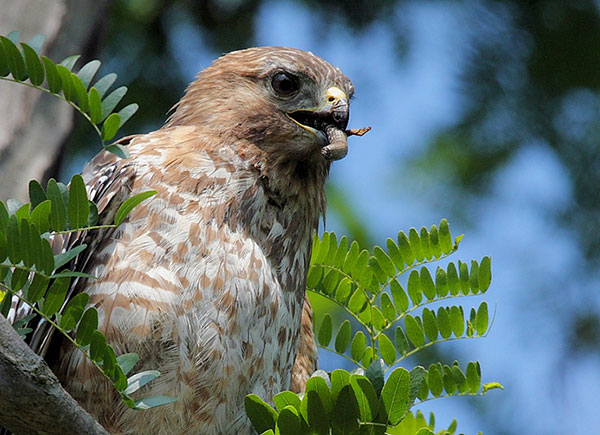
Red-shouldered Hawk enjoying a snack
The Red-shouldered Hawk eats small mammals, reptiles, amphibians, large insects, and aquatic crustaceans. It spots them either from perches or while in flight. The largest prey items are the size of a squirrel or a rabbit. Interestingly, crayfish can be an important food source where abundant.
Location
These two species also differ regarding the habitats they prefer.
Red-tailed Hawk have a wide range of habitats, including scrub desert plains, pastures, mountain grasslands, agricultural fields, parks, and patchy forests (deciduous, coniferous, or even tropical rainforests). The common trait that connects these habitats is that they are open areas with sufficient elevated perches.
On the other hand, Red-shouldered Hawks prefer moist deciduous woodlands. You’ll often see themalong riverbeds and near wetlands, where they also gladly nest. These raptors dislike dry climates or populated areas.
Nest & Eggs
The Red-tailed Hawks build their nests at forest edges, in large trees surrounded by open land, 13-68 feet above the ground. Where trees are few, they can build nests on cliffs and artificial structures like buildings.
The Red-tailed Hawk pair commonly uses the same for several years and is made by both males and females. The primary construction materials are twigs, and they also use bark, pine needles, catkins, moss, and other soft plant materials for nest lining.
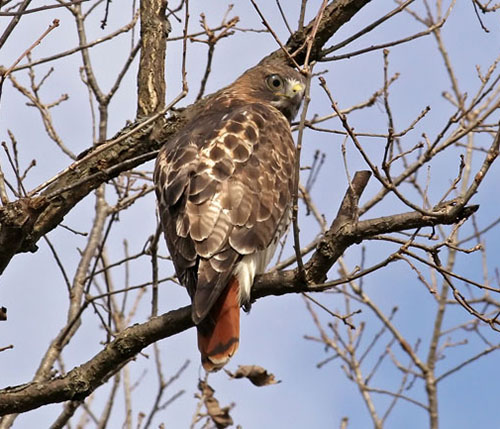
A female lays 1 to 5 eggs, white or buff, with blotches and speckles of buff, brown, or purple. Both parents incubate the eggs for 28 to 35 days.
Owls are grave nesting site competitors of the Red-tailed Hawks. Both species destroy each other’s eggs and kill (and eat) the young when taking over a nesting site.
Red-shouldered Hawks like to nest in the forks or branches of large trees 20 to 60 feet above ground level. Both parents participate in the building process and include sticks, other vegetation, and moss. The nests are sturdy, and the pairs will frequently use them for several seasons.
The Red-shouldered female lays 3 to 4 eggs, white with brown or lavender patches. Both parents will incubate them for 33 days before hatching.
We can conclude that both species have similar nesting habits, with little to no differences in preferred nesting sites, egg coloration, incubation, and parental care.
Red-tailed Hawk vs Red-shouldered Hawk – Frequently Asked Questions
How to tell the difference between a Red-tailed Hawk and a Red-shouldered Hawk?
On average, individuals of the two species are easiest to tell apart by their tails. While the Red-tailed Hawk’s namesake tail is orange from both up and below (excluding those belonging to juveniles and extremely dark and light morphs) and long, the Red-shouldered Hawk has a somewhat shorter and dark-and-white banded tail.
Another trait to look out for is the wings. In Red-tailed, they are broad and rounded, while in Red-shouldered, the wings are somewhat narrower in flight and sort of squared off at the tips. Also, there is that typical wing underside color pattern – rusty-orange with banded black and white flight feathers.
How rare is a Red-shouldered Hawk?
The Red-shouldered Hawk is still considered a common hawk species and the scientists officially call its populations stable. However, in reality, its range and the opportunities to observe it have declined. The decline follows the shrinking of North American forests, as the Red-shouldered is closely connected to deciduous and mixed forest habitats near water bodies.
You will most likely spot it along the Atlantic Coast, where it is a permanent resident in the west and the south. It is also found along the coast of California. All in all, Californian and Floridian populations seem to have better adapted to open habitats, so they are easier to observe.
On the other hand, in some areas like the upper Midwest and some parts of the Atlantic Coast, the Red-shouldered Hawk has definitely become rarer.
Which one is bigger – the Red-tail Hawk or the Red-shouldered Hawk?
The Red-tailed Hawk is slightly bigger than the Red-shouldered Hawk. The Red-tailed Hawk females can measure up to 65 cm in length, and the Red-shouldered females up to 61 cm. However, the difference in weight is more obvious – Red-tails have been known to measure 1220 grams, while the Red-shouldered can reach up to 700 grams on average.
Red-tailed Hawks can also have a considerably bigger wingspan – up to 135 cm. Contrastingly, the span of the Red-shouldered Hawk’s wings rarely exceeds 100 cm.

Linda Shirey
Tuesday 28th of November 2023
Are red-shouldered hawk calls used for eagle calls in movies and TV? I have read that red-tailed hawk calls but thought that red-shouldered hawk calls were used also. I will be making a presentation on red-shouldered hawks and don't want to present false information. Thank you.
Patrick O'Donnell
Wednesday 29th of November 2023
@Linda- Mostly, we hear the shrill descending typical raptor scream of the Red-tailed Hawk. However, on occasion, yes, I have also heard Red-shouldered Hawks in movies and television shows.